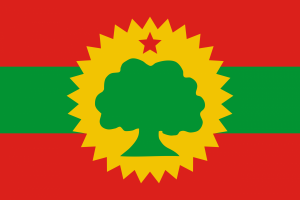Language/Borana-arsi-guji-oromo/Vocabulary/Self-Introduction
| ◀️ Common Greetings — Previous Lesson | Next Lesson — Traditional Festivals ▶️ |
Welcome to the "Self-Introduction" lesson of our Borana-Arsi-Guji Oromo course! In this lesson, we will embark on the exciting journey of learning how to introduce ourselves and ask for someone's name in the Borana-Arsi-Guji Oromo language. This skill is crucial, as self-introduction is often the first step in building connections and friendships in any culture.
Understanding how to express who you are and inquire about others will open doors for you in your interactions with the Oromo community, whether in social gatherings, cultural exchanges, or even while traveling in Oromia.
We will cover the following topics in this lesson:
Importance of Self-Introduction
Self-introduction is not just about stating your name; it reflects your identity, background, and personality. In the Borana-Arsi-Guji Oromo culture, introductions hold significance, as they set the tone for future interactions. By mastering this skill, you will not only enhance your language abilities but also show respect for the culture and people you are engaging with.
Key Vocabulary for Self-Introduction
Let's dive into some key phrases and vocabulary essential for self-introduction in Borana-Arsi-Guji Oromo. Below, we will provide a table with common phrases used when introducing oneself.
| Borana-Arsi-Guji Oromo | Pronunciation | English |
|---|---|---|
| Ani | /aːni/ | I am |
| Maqaan koo | /maːqaːn koː/ | My name is |
| Ati eenyu? | /aːti eːnjuː/ | Who are you? |
| Maqaan kees | /maːqaːn keːs/ | Your name is |
| Nagaa | /naɡaː/ | Peace |
| Galatoomi | /ɡalataːmi/ | Thank you |
| Baga nagaan dhuftan | /baɡa naɡaːn duːftan/ | Welcome |
| Akkam jirtu? | /akːam dʒirtuː/ | How are you? |
| Jirra | /dʒirːa/ | We are |
| Baga gammade | /baɡa ɡammada/ | Nice to meet you |
How to Formulate Your Introduction
Now that we have a list of essential phrases, let’s look at how to put them together into a coherent introduction. Here is a simple structure you can follow:
1. Start with a greeting: Use “Nagaa” (Peace) or “Baga nagaan dhuftan” (Welcome).
2. Introduce yourself: Say “Ani [your name]” (I am [your name]).
3. Ask for their name: Use “Ati eenyu?” (Who are you?).
4. Express pleasure in meeting: Use “Baga gammade” (Nice to meet you).
For example, you could say:
"Nagaa! Ani John dha. Ati eenyu? Baga gammade!"
(“Peace! I am John. Who are you? Nice to meet you!”).
Cultural Context
Understanding the cultural context surrounding introductions is vital. The Borana-Arsi-Guji Oromo people value respect and politeness. When you introduce yourself, maintain eye contact, smile, and use a friendly tone. This will not only help you communicate better but also demonstrate your respect for the individual you are addressing.
Example Conversations
Here are some example conversations demonstrating self-introductions:
| Conversation Scenario | Borana-Arsi-Guji Oromo | Pronunciation | English |
|---|---|---|---|
| Meeting someone new | Nagaa! Ani Amina dha. Ati eenyu? | /naɡaː! aːni aːmina dha. aːti eːnjuː?/ | "Peace! I am Amina. Who are you?" |
| Asking for a name | Ani Juma dha. Maqaan kees eenyu? | /aːni dʒuma dha. maːqaːn keːs eːnjuː?/ | "I am Juma. What is your name?" |
| Welcoming someone | Baga nagaan dhuftan! Ani Ahmed dha. | /baɡa naɡaːn duːftan! aːni aːhmed dha/ | "Welcome! I am Ahmed." |
| Conversing with a friend | Nagaa! Ani Mariam dha. Ati akkam jirtu? | /naɡaː! aːni maːriːam dha. aːti akːam dʒirtu?/ | "Peace! I am Mariam. How are you?" |
Practice Exercises
To solidify your understanding of self-introduction, let's engage in some practice exercises. Below are ten scenarios where you can apply what you've learned.
1. Write a self-introduction for yourself using the vocabulary and structure from this lesson.
2. Create a dialogue between two people meeting for the first time, including greetings and self-introductions.
3. Practice asking a friend for their name in Borana-Arsi-Guji Oromo.
4. Record yourself saying your introduction and listen to it to improve pronunciation.
5. Pair up with a classmate and practice introducing yourselves to each other.
6. Write a note introducing yourself to someone in the class.
7. Create a visual representation (like a poster) of your introduction in Borana-Arsi-Guji Oromo.
8. Use a mirror to practice your introduction, focusing on body language and facial expressions.
9. Role-play a scenario where you meet someone new at a cultural event.
10. Formulate responses to common follow-up questions after your introduction.
Solutions and Explanations for Exercises
1. Example Self-Introduction: "Nagaa! Ani [Your Name] dha. Ati eenyu? Baga gammade!"
2. Dialogue:
- Person A: "Nagaa! Ani Amina dha. Ati eenyu?"
- Person B: "Nagaa! Ani Juma dha. Baga gammade!"
3. Asking for Name: "Maqaan kees eenyu?"
4. Recording: Listen to the recording and note areas for improvement in pronunciation.
5. Pair Practice: Switch roles after one person has introduced themselves.
6. Note: "Nagaa! Ani [Your Name] dha. Maqaan kees eenyu?"
7. Poster: Include your name, greeting, and a visual element that represents you.
8. Mirror Practice: Observe how your body language affects your communication.
9. Role-Playing: Use the vocabulary learned to create a lively interaction.
10. Common Follow-Up: Prepare answers for questions like "Where are you from?" or "What do you do?"
As you practice these exercises, remember to focus on both the language and the cultural nuances that make self-introduction in Borana-Arsi-Guji Oromo unique.
By the end of this lesson, you should feel confident in your ability to introduce yourself and inquire about others. This foundation will serve you well as you continue your journey to mastering the Borana-Arsi-Guji Oromo language.
Other Lessons
- Fruits
- Languages Afaanoota
- Feelings and Emotions
- Describing Relationships
- Animals
- Geography
- How to Say Hello and Greetings
- Drinks
- Count to 10
- Days of the Week
Template:Borana-arsi-guji-oromo-Page-Bottom
| ◀️ Common Greetings — Previous Lesson | Next Lesson — Traditional Festivals ▶️ |

